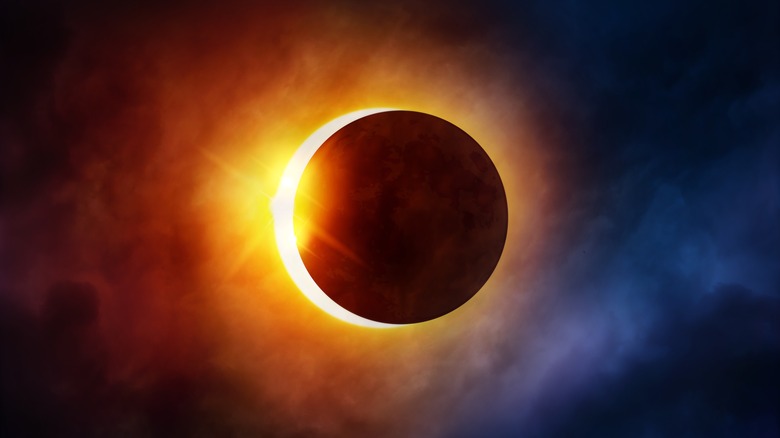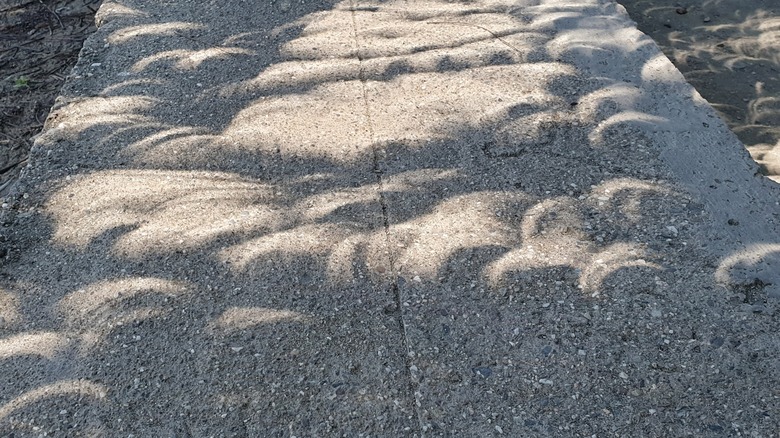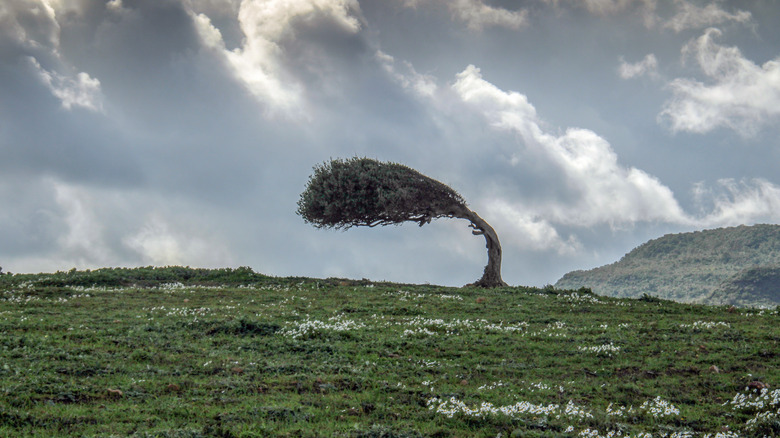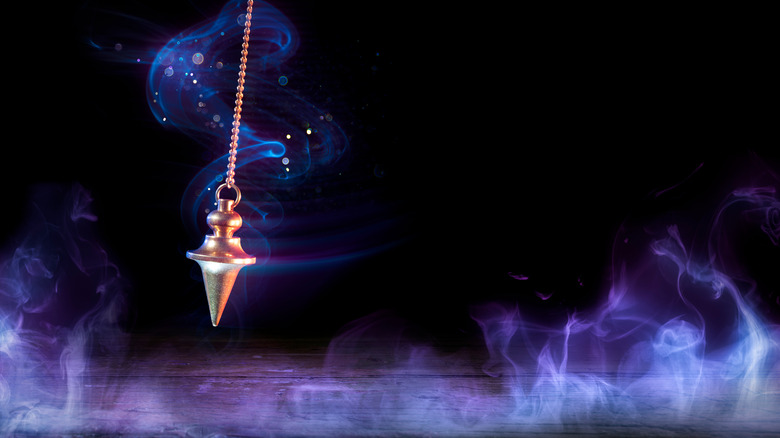Strange Things That Happen During Solar Eclipses
You could imagine that for ancient peoples, solar eclipses must have been terrifying, ominous occurrences, indeed. Did some god grow angry with humanity and turn its back on us? That's what folklore in Transylvania (modern-day Romania) whispered. Should we shoot some flaming arrows at the sun to try and catch it on fire and turn it back on? That's what the Chippewa (aka the Ojibwe tribes) in North America thought. Or did the giant wolf Fenrir finally swallow the sun during the cosmos-ending, final battle of the gods, aka the myth of Ragnarök? We'd have to ask ancient Norse peoples about that one.
Thankfully — or disappointingly, depending on your love of fantastical explanations — we've got no evidence of godly activity during eclipses. There are also no monsters roaming the planet, sickness falling from the sky, sudden onsets of blindness, dangers to pregnant women, or anything else that people once believed. That being said, eclipses can certainly come across as mystical, even disturbing events, especially if someone isn't up to speed on their sciences.
However, strange things do happen during solar eclipses. Such things might not be as bizarre as giant wolves eating the sun, but they're still unexpected. Animals, for example, often display different behavior during eclipses — after all, it suddenly looks like nighttime. But beyond animals, solar eclipses affect shadows and the visibility of the heavens, interfere with radio waves, change wind patterns and temperatures, alter gravity (maybe, but only a bit), and might even alter the growth of microorganisms.
Playing with light and shadow
Because solar eclipses affect sunlight above all else, witnesses can expect to behold some nifty — if not weird — phenomena on eclipse day related to light and shadow. Pinhole shadows are amongst the prettiest of ecliptic events, caused by light streaming through objects, particularly tree leaves. You know how light cast through leaves spreads dappled shadows on the ground? Pinhole shadows are like that, but they take on an arced shape as the moon starts passing in front of the sun.
Looking up to the sun itself (don't do that during the eclipse without special glasses, by the way), viewers might notice little light bubbles around the rim of the moon. Known as "Baily's beads" — named after 19th-century astronomer Francis Baily — these beads of light come from the uneven surface of the moon. There are just enough variations in height across the moon's surface to cause some extra sunlight to peak past its rim at certain points during a solar eclipse, even a full one.
Finally, but least strangely, reduced sunlight during a solar eclipse means that amateur astronomers can get some extra-good glimpses of planetary bodies in our solar system. Both Venus and Jupiter, for instance, should be visible during the upcoming April 8, 2024 solar eclipse — depending on where you live. Things might not get pitch black during a solar eclipse, but dimmed light levels cut out the glare that obscures the sight of the stars and planets during the day.
Surges and drops in temperature and wind
Next on the list is a common sense item that might seem odd until you stop to think about it. When the moon passes in front of the sun and blocks all of the sun's lovely, life-giving rays, what do you figure happens to the temperature on Earth? If you guessed, "It goes down," then ding, ding, you're correct. Temperatures typically drop by around 5 to 10 degrees Fahrenheit, an effect similar to standing outside on a sunny day and feeling the temperature drop when a cloud passes in front of the sun. In the case of a solar eclipse, however, it's not clouds that block sunlight, but the moon.
Hand in hand with temperature drops is something else that folks might not automatically associate with a solar eclipse: wind changes. Wind occurs, in large part, because of temperature differences. Differences in heat cause air to move in a certain direction, which pushes away the air that's already there, and so on. Wind on our spherical Earth gets quite a bit more complicated because Earth's rotation causes wind to curve north or south — a phenomenon known as the Coriolis effect. Regardless, wind generally slows down as the moon starts to cover the sun, and then speeds up when the sun is totally covered. At that point, a study published in the Philosophical Transactions of the Royal Society A states that the wind moves in a different direction.
Radio interference
Besides messing with light, shadow, temperature, and wind, solar eclipses can also interfere with radio waves. But unlike the other strange occurrences on this list, radio interference requires a bit more of a technical explanation. For that we can take a cue from one of the most gorgeous sky happenings beheld by humanity: auroras. Auroras happen because of electrically charged particles — ions — emitted by the sun. Because ions have an electric charge they get snared by Earth's magnetic field and slide along toward the north or south pole. It's the impact of ions against the Earth's magnetic field that creates the beautiful colors associated with auroras.
All this is to say: Earth is constantly being bombarded by charged particles from the sun. It's also being bombarded by trillions — yes, trillions — of cosmic rays from space every single day. And when we humans turn on radios and emit more electromagnetic energy into the mix things can get extra complicated. In short, solar eclipses block emissions from the sun, which somehow interferes with radio signals on Earth. Researchers don't exactly know how, but the connection is clear. NASA has even published precise instructions on how to tune into and observe fluctuations in radio emissions during the impending April 8, 2024 eclipse. Global radio enthusiast communities like Radio Jove even encourage curious folks to get involved, gather data, and maybe even figure out precisely how the eclipse mucks up radio waves.
Differently-swinging pendulums ...?
This next item falls firmly in the realm of weird, and has caused a bit of a stir since its original discovery in 1954 — or perhaps we should say "discovery." Back then amateur scientist Maurice Allais — who won the Nobel Prize in economics in 1988, by the way — thought that maybe, just maybe, solar eclipses could alter gravity. If they did then it would mean our understanding of gravity is somehow broken. So, Allais set up a Foucault pendulum to check if its swing changed during an eclipse. Normally, the swing of a Foucault pendulum changes as Earth rotates, and also if you're closer to the equator. But lo and behold: Allais discovered that the precession of his pendulum — the orientation of the swing over time — changed during a 1954 solar eclipse, a phenomenon dubbed the "Allais effect."
The only problem? It's proven difficult to reproduce Allais' results. Various research papers investigating the Allais effect have cropped up over the years, such as a 2017 paper in the International Journal of Astronomy and Astrophysics or a 2020 paper in the Journal of Modern Physics, but the scientific community remains doubtful and without a consensus on the matter. At the very least: If solar eclipses do affect gravity, they don't affect it in any way that impacts human life. If they did we'd know it already, so don't go expecting to float into the air during the next solar eclipse.
Microscopic growth and shape changes
Finally, it seems that not only do solar eclipses affect large animals, but small, microscopic creatures as well. At least, they might. Much like the previous entry, this affect is still being investigated, and not wholly confirmed by the scientific community at large.
Back in 2011, a study published in the Journal of Pharmacy and BioAllied Sciences found that solar eclipses change the growth and morphology (shape) of microbes. The study in question tested three kinds of bacteria and one type of fungus. It found that all of the samples changed growth patterns and shape depending on whether or not they were exposed to normal sunlight or the diminished sunlight of an eclipse. But since a partial eclipse phase lasts 70 to 80 minutes (when the moon is moving in and out of place), and a total eclipse only up to 7.5 minutes, the researchers in question must have only had a very short range of time within which to gather their data.
At present it looks like the topic of ecliptic bacterial growth hasn't really caught the interest of any other researchers, because no one else has stepped up to try and reproduce the results of the study in question. So is it possible that solar eclipses affect how bacteria reproduce? Sure. But when solar eclipses happen most people are too busy staring up at the sky to take notice, and maybe even imagining that a giant wolf is eating the sun.





